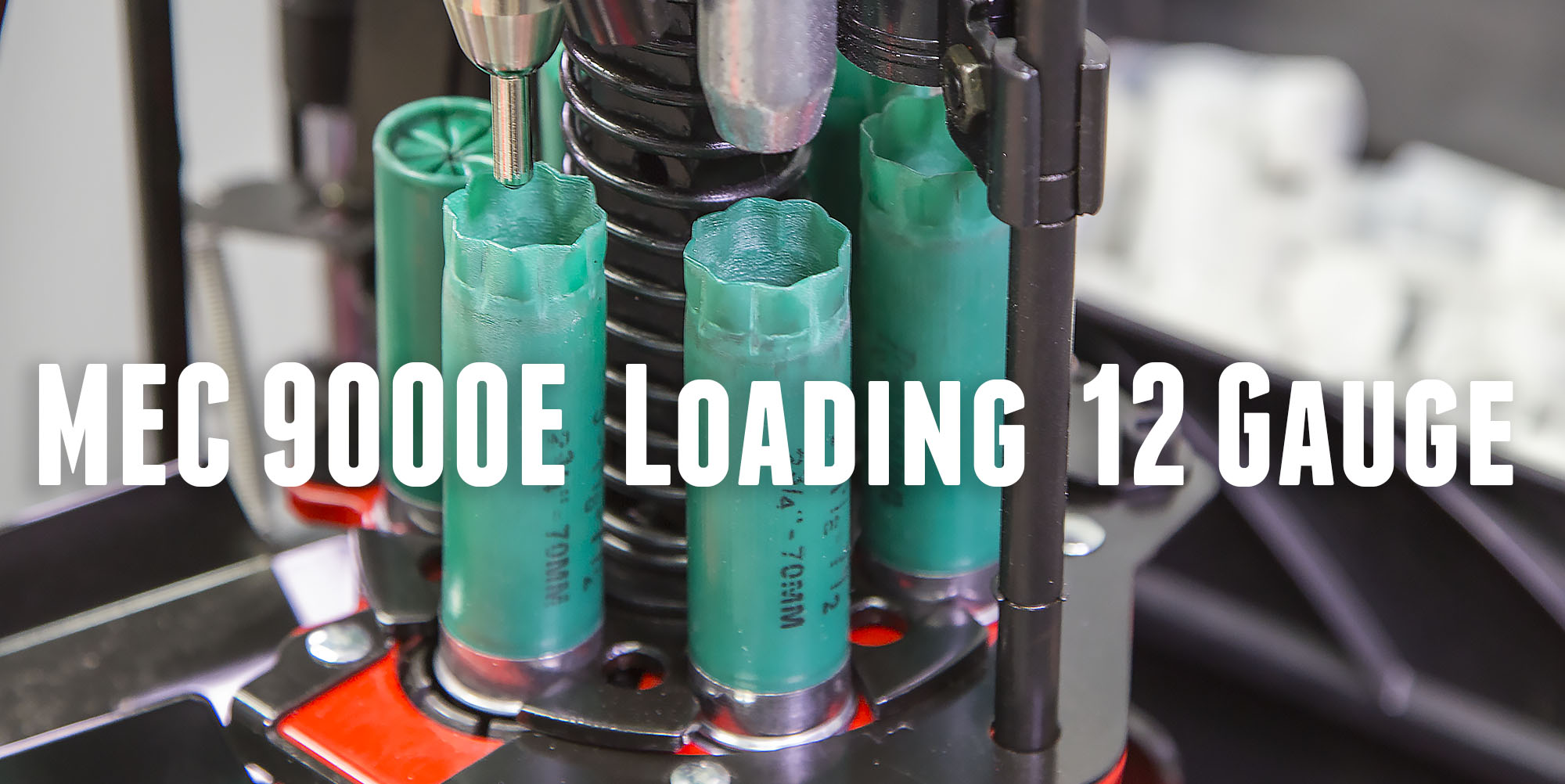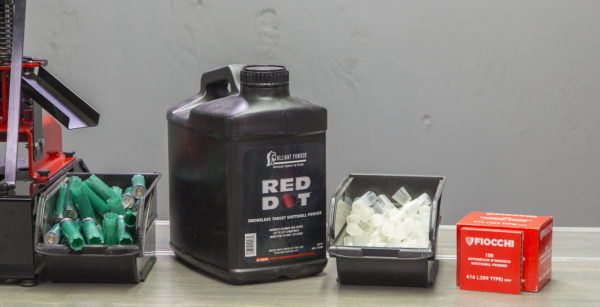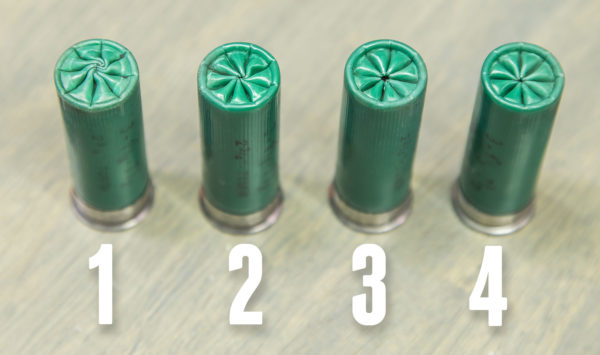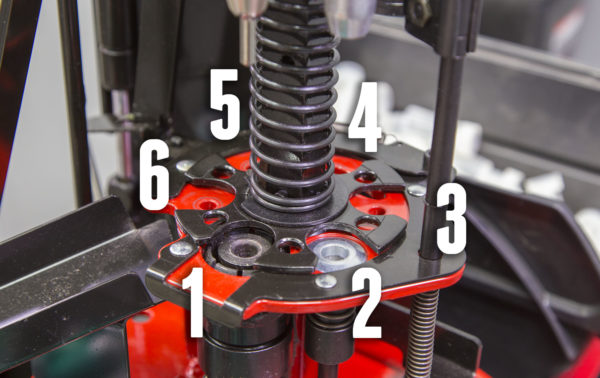Getting the MEC 9000E with Auto-Mate reminds me of a recent experience involving my Case 580 backhoe, and a shovel. After owning my ~16,000lb 4×4 backhoe with 4×4 and extendahoe, I had to do some digging with a shovel. Let me just say that about 5 minutes into digging with the shovel, I exclaimed out load “I can’t do this- I need my backhoe!”. Yes, I’m totally spoiled now, and once you have an industrial tool, it’s hard to go back to the “backbreaking way”. Loading 12 gauge with the 9000E and Auto-Mate has done the same thing to me! Check it out:
My 12 Gauge Pet Load
One thing I like about shotshell reloading is the fact that when you find a pet load, it’s pretty easy to duplicate that load, and once I get a press setup to load shotshells, I rarely need to make changes. So I wanted to share with you my go-to pet load for 12 gauge shells!
The components I’m using from left-to right: (and load data)
- Remington Gun Club once fired hulls
- Alliant Red Dot Powder – 18.0 grains
- Winchester AA wads
- Fiocchi 616 209-type primers
- #8 shot – 1 1/8 oz. (not pictured)
Use load data at your own risk. Ultimate Reloader is not responsible for errors in load data on this website. Always cross-reference load data with manufacturer’s published data.
Preparing the MEC 9000E for Loading
In the last post, I performed a full unboxing and “baseline setup” of the MEC 9000E with Auto-Mate. Before loading shotshell ammunition, there’s still some final preparations and adjustments that I had to make.
These steps included:
- Filling the shot and powder reservoirs
- Validating powder charge and swapping powder charge bushings as needed (I ended up swapping a #32 bushing in to get 18.0 grains of Alliant Red Dot)
- Optional: swap charge bars if different shot or shot charge is called for (I used the 1 1/8 oz charge bar that comes with the press)
- Test loading shells, checking and adjusting crimp and components (example: swap out wads to compensate for volume issues)
As outlined in the video, I had to make a couple adjustments to the pre-crimp station, and the main crimping station. After that, things we dialed in!
Here’s what my sequence of crimp adjustments resulted in:
As outlined in the picture:
- First shell through the press – this would shoot fine, but will thrash the hull, and is super-ugly
- Main crimp station elevated, still not high enough (note swirl)
- Main crimp station elevated, too high (note hole)
- Main crimp station lowered slightly, pre-crimp station elevated slightly – PERFECTION!
Once I made these adjustments (which were very easy) I didn’t have to touch any adjustments again- every shell has come out looking great. That’s what I love about shotshell reloading on a quality piece of gear.
Loading 12 Gauge Shells in Bulk
Once things were dialed in, loading has been smooth sailing (once I figured out how this press likes to be run!). Here are the stations that are involved in loading on the MEC 9000E with Auto-Mate:
…and here’s what each station does:
- De-priming and collet sizing of base
- Priming and powder charge
- Wad insertion and shot charge
- Pre-crimp (crimp starter)
- Crimp
- Taper crimp (aids in feeding in shotgun)
Sounds complicated, but once you load for about 10 minutes, you’ll be cruising smoothly. Here are a few tips I’ve learned about running the MEC 9000E with Auto-Mate:
- Push the shell all the way in when inserting in station #1 – if you don’t, issues may result
- Hold the buttons down on the Auto-Mate until the press is in the bottom position, plus a tick more for good measure (1/10 second)
- When validating powder charge, if you remove the shell from the press, put an empty hull in station #3 on the next actuation to catch the shot, else shot will spill everywhere. Don’t ask me how I know this. 🙂
- When inserting a wad in station #3 carefully make sure the petals are over the punch, else the wad will crush
- Like with any press, take things slowly at first, then build up speed.
- Always keep an eye on your components (primers, powder, shot) as you are loading and add more before you run out!
- If something doesn’t look right or sound right, stop and take a look. Take your time and be patient (yes, easier said than done)
Now that I’m loading shells on the 9000E with Auto-Mate, I’m feeling a tad spoiled, and it’s motivating me to load a TON of shells. There are a lot of great tools out there to load shotshells, but the 9000E with Auto-Mate is my favorite yet.
Do you have a MEC 9000E with Auto-Mate? I’d love to hear your experiences- please leave a comment!
Thanks,
Gavin






















































































This is an amazing setup! I am curious what these cost per round though. I reload everything I shoot EXPECT 12 gauge because I can buy cases at Cabela’s for 22 cents a shell. I just can’t seem to find a recipe that is cheaper then that to reload.
I have the MEC9000 press as well as a single stage MEC. I haven’t used them in years because it has been just as cheap or cheaper to buy shells at Walmart or online. I prefer the single stage press for loading buck or slugs. I live in California so that means in 2018-19 I have to go back to reloading shells. The MEC9000 is a good press and progressive is the way to go! I however find the lever a little hard to pull and after a while it’s not fun anymore. I think the auto drive is the way to go and after watching your video I may get one. Thanks /John
Although I load metallic most of the time, I really enjoy reloading shot shells. I have a Mec Sizemaster in 12 gauge. It’s a fine piece of equipment.
Just a comment about Mec. I bought my first Mec 600 JR. when I was 16. I am 73 now and still using it. I also bought a used Mec 600 JR, a few years ago on Ebay so I didn’t have to change dies from 12 ga. to 20 ga. Now I have one for each ga. Good equipment if taken care of.
I love my 4 gauges of 9000 E
A few comments from 35 years of reloading 12, 20, 28, and .410 shotgun shells for Skeet and Trap. While 12 and 20 gauge shells can be purchased fairly cheap, reloading the smaller 28 gauge and .410 shells will save you a bunch. The difference is in the cost of the lead shot. Another consideration for loading 12’s and 20’s is that you can load some very light recoiling shells with less shot or powder or both. You can’t purchase shells like this. Plus I find reloading part of the shooting hobby. It is relaxing and rewarding shooting and breaking claybirds with loads I created.
A word about 1 ounce 12 gauge loads. The pattern just as well as 1-1/8 ounce loads and recoil less. Many of my fellow Skeet shooters are going to 7/8 ounce 12 Gauge loads (I have been shooting this load for years). The same goes for 20 gauge 7/8 ounce loads which can be reduced to 3/4 ounce. It’s not about how much shot you pack into the shell or how much velocity. The difference if lead (forward allowance) between a 1200 – 1300 fps load and a 1150 fps load is a matter of inches. High velocity heavier loads kick more causing flinching, head lifting, and gun stoppage, all of which result in missing your target.
Final comment. One of the reasons the Walmart cheap shell are less expensive is that the promotional loads have softer shot. These pellets deform upon firing setback and scrubbing the sides of the barrel as they exit. The more expensive shells like Win AA’s or Rem STS have HARD shot containing around 6% antimony which put more pellets on what you are shooting at. Good Shooting!
Do do any reviews on the Ponsness Warren 375 c or the p w l/s 1000 10 Ga.?
Reloader for steel and other non toxic shot.
I am interested in a 10 Ga. Reloader but need some insight to which one the pw
or the mec steel master.
Thanks for any reply that will help me decide.
Eddie
Upon starting up the machine, how did he not get powder and shot all over when it cycled. Down on de-prime would cycle the powder and shot with no shell in place. Down on prime-powder would also drop shot all over the machine and bench. Must be magic!!
A bit late to the party, but I just got a 9000 a few weeks ago. There is an arm that locks the charge bar in the far left position when no shell is in station and that prevents left to right movement that will drop a powder charge.